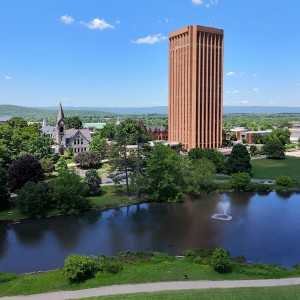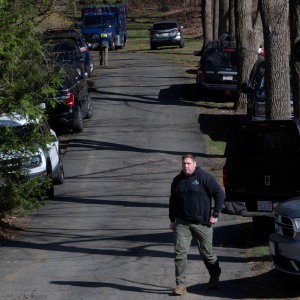Tracking the path of totality: In a visit to Mount Holyoke, astrophysicist talks about upcoming total solar eclipse

This map shows the path of April 8’s solar eclipse. NASA
| Published: 02-11-2024 6:01 PM |
SOUTH HADLEY — On April 8, as the earthbound jostle to find a spot to see the total solar eclipse, Jenna Samra will be 45,000 feet above the crowds in a Gulfstream 5 jet, aiming to stay in the moon’s shadow just a couple of minutes longer.
An astrophysicist at the Center for Astrophysics (CfA)-Harvard & Smithsonian, Samra spoke Thursday at Mount Holyoke College on her team’s project to observe and glean scientific data from the sun’s corona during an eclipse. The corona is the outermost part of the Sun’s atmosphere that is usually hidden by the bright light of the Sun’s surface, though it can be viewed during a total eclipse.
Solar eclipses take place roughly every two years, but a total eclipse can only be seen within a narrow band. A partial eclipse will be visible April 8 throughout North America, clouds permitting. Starting at the Texas border, the 115-mile band of totality stretches northeast from the Rio Grande to the Canadian Maritimes.
Samra has been chasing solar eclipses in an airplane since 2017 because the brief obliteration of the sun’s disc provides a rare view of the solar corona.
“At totality, we can see this beautiful crown around the sun,” she said. “We can’t see it normally because it’s a million times dimmer than the sun. It’s a perfect opportunity to study the corona.”
Images of the corona show a halo of streamers and loops fed by solar flares, coronal mass ejections and other activity in its magnetic field. The intense energy can be felt on Earth, affecting satellites and interfering with radio communications and the power grid.
Part of studying solar activity is to improve our readiness for geomagnetic storms, Samra said. The National Oceanic and Atmospheric Administration defines a geomagnetic storm as a major disturbance of Earth’s magnetosphere that occurs when there is a very efficient exchange of energy from the solar wind into the space environment surrounding Earth.
“Space weather predictions are not so good,” she said. “We need to understand more.”
Article continues after...
Yesterday's Most Read Articles
 Student petition leads Amherst Regional High to reopen bathrooms during lunch; school will explore other ways to address vaping
Student petition leads Amherst Regional High to reopen bathrooms during lunch; school will explore other ways to address vaping
 UMass faculty calls on land grant universities to join in fight against Trump administration; McGovern, AG also weigh in
UMass faculty calls on land grant universities to join in fight against Trump administration; McGovern, AG also weigh in
 Raising alarm: Towns over Barnes Aquifer raising alarm over lithium battery storage facility planned for Westfield
Raising alarm: Towns over Barnes Aquifer raising alarm over lithium battery storage facility planned for Westfield
 Hadley man detained after chemicals go missing
Hadley man detained after chemicals go missing
 Jones Library project in Amherst a go: Effort to rescind $46.1M in funding fails at emergency meeting
Jones Library project in Amherst a go: Effort to rescind $46.1M in funding fails at emergency meeting
 Guest columnist Bryan Jersky: The facts about Northampton school meals
Guest columnist Bryan Jersky: The facts about Northampton school meals
While inside the plane during the total eclipse, Samra’s team will use infrared imaging equipment and a spectrometer to break up white light into its constituent colors. Infrared imaging has some advantages — it picks up light outside of the visible spectrum — but the equipment needs to be cooled to an extreme degree.
Heat is light in the infrared range, so the team uses liquid nitrogen to cool the equipment to minus-320 F. And it needs to be in a vacuum to prevent condensation from forming.
The team uses mirrors to track the sun and a gyroscope to stabilize the equipment as much as possible inside a moving plane.
For 2017’s eclipse, they flew over Kentucky, learning that they hadn’t cooled the equipment quite enough. In 2019, they flew so far west from Lima, Peru, they had to land on Easter Island — a nice reward for a scientific expedition. With a tailwind on that occasion, they spent 9 minutes in totality, and their image quality improved.
Work is still ongoing on the new equipment, dubbed the Airborne Control Emission Surveyor (ACES).
“We’re building an instrument that’s not ready,” Samra acknowledged upfront.
Flying out of Tucson, Arizona, to avoid likely crowds closer to the path of totality, the team aims to catch up with the eclipse between Dallas and Austin. Staying parallel to the moon’s path, they hope to remain within the full shadow for 6 minutes. People on the ground may experience up to 3 or 4 minutes of totality.
Even in a plane at 560 mph, it’s impossible to keep with the moon, which moves at 1,600 mph, Samra said.
Predicting the wind is key, and the team needs to practice flying the same track twice. They hope to be ready for test flights by the second half of March.
Here in Massachusetts, about 95% of the sun’s disc will be obscured at the peak of the eclipse, but in terms of brightness, it’s a long way from 100%.
“Totality is very, very different from 95%,” she said, encouraging audience members to travel to see the total eclipse.
In the Northeast, Buffalo, Watertown, New York, Burlington, Vermont, and Houlton, Maine, are all close to the center of totality. In Burlington, a partial eclipse begins at 2:14 p.m., totality is from 3:26 to 3:29, and the partial eclipse ends 4:37.
For her part, Samra said she’s excited to see emission lines in the corona that have never been seen before. Solar activity is on the increase, and she expects to see a more disordered corona with brighter lines.
“If it works, we can propose a satellite, or a high-altitude balloon over Antarctica” for longer-term measurements, she said.
James Pentland can be reached at jpentland@gazettenet.com.






 Area briefs: Haydenville church Easter Soup & Bake Sale; Frontier Community Access editing drop in hours; Northampton Democratic City Committee to caucus; Traffic advisory for DAR State Forest
Area briefs: Haydenville church Easter Soup & Bake Sale; Frontier Community Access editing drop in hours; Northampton Democratic City Committee to caucus; Traffic advisory for DAR State Forest Community printing hub takes shape in Easthampton
Community printing hub takes shape in Easthampton
